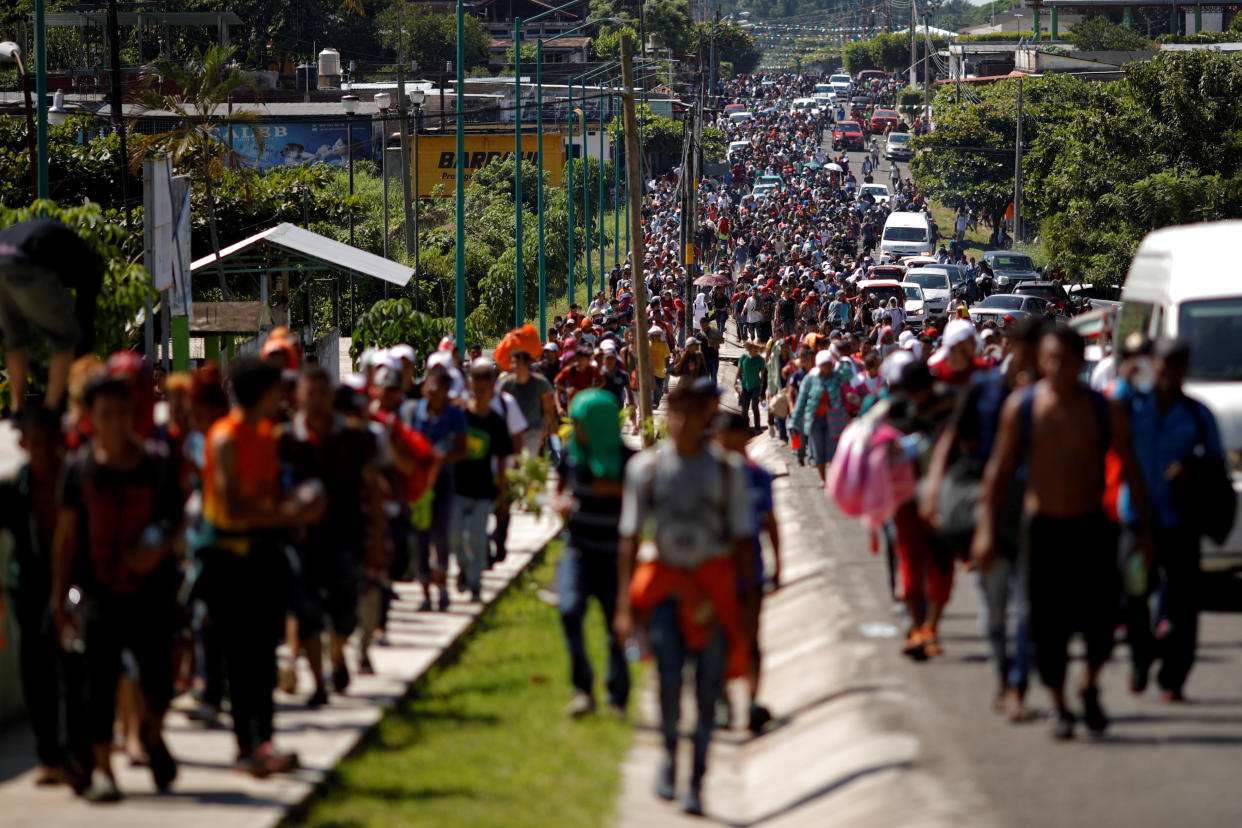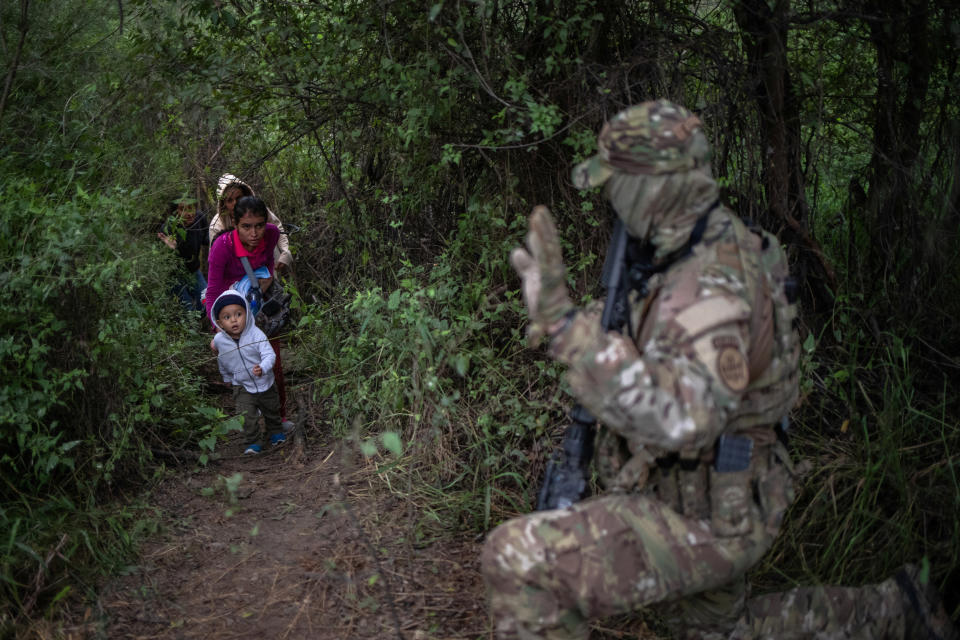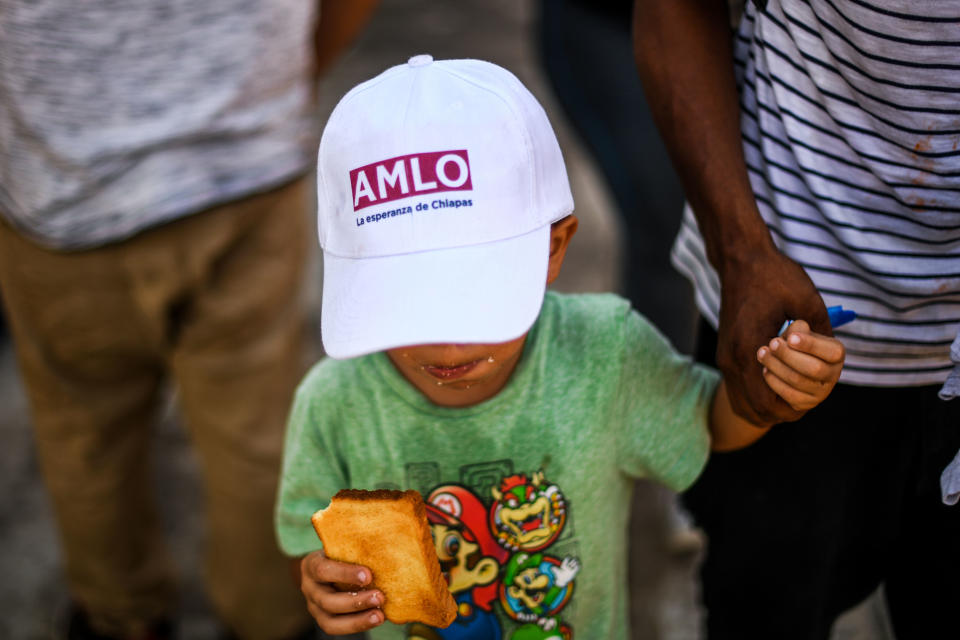The 'Democratic loopholes' the White House blames for border crisis

As President Trump continued his misinformation campaign about the caravan of predominantly Central American migrants making its way through Mexico toward the U.S. border — promoting the unsubstantiated claim that “unknown Middle Easterners” and criminals are among the more than 7,000 migrants — members of his administration outlined the tangle of legal issues that they say have created a “grave threat to America’s sovereignty,” and sought to put the blame on “Democratic loopholes” in the law.
Speaking on background, senior administration officials said their hands were tied by the William Wilberforce Trafficking Victims Protection Reauthorization Act of 2008, named for an English abolitionist and better known as the TVPRA. The bill, which added new language about the treatment of unaccompanied immigrant children to the original Trafficking Victims Protection Act of 2000, was meant to strengthen protections against sex trafficking of children; it passed the Senate by unanimous consent and was signed without controversy by Republican President George W. Bush. In recent years, it has been blamed for encouraging the flow of immigrant children from Central America because of a provision that requires all unaccompanied minors from non-contiguous countries (anywhere other than Mexico or Canada) be transferred to the custody of the Department of Health and Human Services within 72 hours, guaranteed an immigration court hearing and placed in the “least restrictive setting possible” while their cases are pending. Border Patrol agents who apprehend unaccompanied children from Mexico, on the other hand, are given 48 hours to determine whether they are victims of trafficking or have credible fears of persecution at home — and if not, they can be quickly repatriated to Mexico.

“What we’d like to convey more than anything else [is] the unique nature of the border crisis today is that the aliens are being apprehended but they cannot be removed,” said one senior White House official, referring to the fact that unaccompanied minors and families from Central America now make up a majority of the undocumented migrants apprehended at the southwest border.
Without mentioning specific legislation, the administration official declared that “virtually every Republican wants to terminate or modify” the Wilberforce law, and “every single Democrat wants to keep” it.
The same administration official argued that the flow of families and unaccompanied immigrant youth from Central America is an outcome of the TVPRA and the 1997 Flores Settlement Agreement — which sets minimum standards for the detention of immigrant children and has been used as an excuse for the ill-fated family separation policy — and the overburdened U.S. asylum system in general, “which has become the world’s largest immigration loophole.”
“These loopholes are a grave threat to America’s sovereignty” and to the “foundations of American society itself,” he said, reiterating that the debate over closing such “loopholes” is a “strictly partisan issue, right down party lines.”
The Trump administration, the official stated, “wants the ability to return whole entire Central American families and also minors after apprehension. If we could do that, there is no border crisis.”
Speaking on background Monday afternoon, senior administration officials provided reporters with the latest statistics from U.S. Customs and Border Protection on apprehensions along the southwest border, pointing to significant rise in apprehensions of family units this past September over the same month the previous year as proof that the U.S. is in the midst of a border crisis. Outside experts dispute that assessment.
Adam Isacson, director for defense oversight at the Washington Office on Latin America, a nongovernmental research and human rights organization, argued that giving Border Patrol the authority to quickly return Central American children and families who they deem unlikely to qualify for asylum or other humanitarian protections would hardly stem the flow of migration from Central America but rather is likely to create an entirely different crisis.
Instead of presenting themselves as asylum seekers to Border Patrol agents or Customs officials at official ports of entry, as most families and children from Central America do now, Isacson said the more likely outcome would be that migrants would be driven to hire smugglers for risky and illegal border crossings through the desert.

Isacson agreed that the immigration court system is not equipped to handle the demand from people fleeing violence, resulting in a huge backlog of cases, and acknowledged that there are some parents who might see the multi-year wait times as an opportunity to “get [their] adolescent kid out of gang recruitment danger” by sending them to the U.S. for a time even if they ultimately lose their asylum case. But he strongly refuted the claim made by one senior White House official Monday that most Central American migrants are simply coming to the U.S. for economic reasons and are coached by “NGOs or radical leftists” to make fraudulent asylum claims.
“What they’re saying there is an insult to the people who do credible fear interviews,” said Isacson, referring to the asylum officers with the U.S. Citizenship and Immigration Services who are trained to assess whether a person who has entered the country without proper documentation has a credible fear of persecution or violence in their home country — the first step toward pursuing an asylum claim.
Leah Chavla, an international human rights lawyer and policy advisor at the Women’s Refugee Commission, emphasized that there is a difference between “coaching” and legal guidance asylum seekers might receive ahead of a credible fear screening.
“It’s frustrating to see due process guarantees and people knowing their rights being described as ‘loopholes,’” she said.
Chavla also dismissed the suggestion made by administration officials Tuesday that the type of persecution and threats described by migrants fleeing Northern Triangle countries doesn’t actually exist.
“That comment seems to be pretty ludicrous,” she said, saying pervasive gang violence is well documented in these countries, and numerous studies show violence causes forced migration. Nevertheless, she said, if people are lying in attempt to seek asylum, “we have to have faith in officers who are adjudicating those claims.”
“It comes down to due process at the end of the day,” she said. “We have a system that was designed for this. The best defense we have [against fraud] is to bolster that system.”
Chavla, echoing other experts in the field, also expressed frustration with the administration’s tactic of comparing the number of migrants apprehended at the border during fiscal year 2018 with that of the previous year, when the rate of illegal border crossings was the lowest it had been since 1971. In fact, while the percentage of families and unaccompanied children apprehended at the border has increased significantly over the past two years, the overall migration numbers remain at historic lows.

By simply comparing the data from the last two years, Chavla charged, the administration is “manipulating it to seem like there is a crisis.”
Meanwhile, Frank Sharry, founder and executive director of the progressive immigration reform group America’s Voice, balked at the administration’s latest attempt to place blame on Democrats for existing immigration policies.
“HA!” Sharry wrote in an email to Yahoo News in response to the claims made during the briefing.
“Republicans control the White House, the Congress and the Supreme Court, and it’s the Democrats’ fault?” he wrote, arguing that Trump and senior advisor Stephen Miller “blew up every serious attempt at bipartisan immigration legislation, including an offer of 25 billion for the stupid border wall in exchange for relief for Dreamers.”
“They’re in charge, they’re responsible and they have failed,” he said.
_____
Read more Yahoo News midterms coverage:
Red-tide awakening: How Florida’s environmental woes could hurt Rick Scott
‘Outside agitators’ phrase resurfaces in Georgia governor’s race
In Texas Senate race, Betomania confronts Trump’s MAGA-rally for Cruz
In Senate race, GOP Rep. Blackburn accuses her opponent of being a Democrat
Photos: Honduran migrant caravan pushes north toward the U.S.
Photos: Violence, poverty and politics: Why Hondurans are escaping to the U.S.



